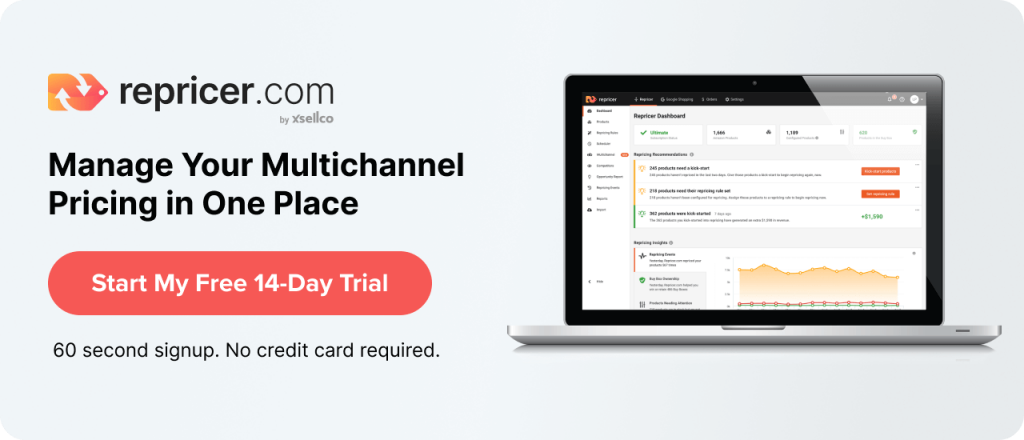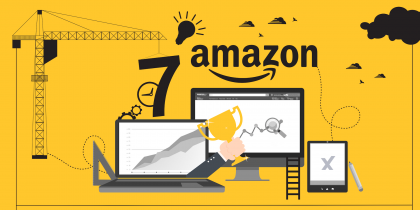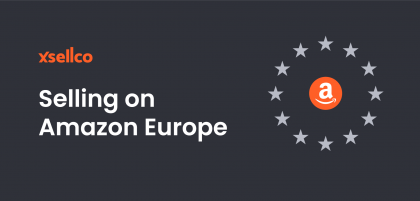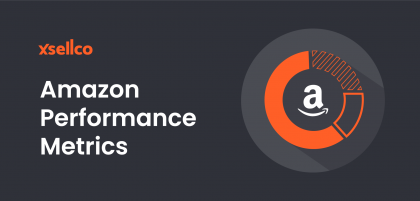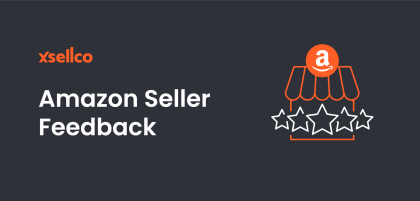Have you ever thought about the logistics of the Amazon Supply Chain? As an Amazon seller, you will likely rely on this chain every day without even realizing what a vast, complex, and critical element it is – and, of course, the fact that it is the element that has contributed the most to Amazon’s success.
Amazon’s supply chain model is one of the largest, most efficient, and state-of-the-art supply chain operations in the world. Yet, its fundamentals are similar to its inception more than 25 years ago – albeit on a much larger scale.
Technological innovations have been embraced over the years to streamline operations and increase efficiency and millions of dollars have been invested so that Amazon’s evolution continues.
Yet, Amazon’s supply chain strategy is one that smaller ecommerce businesses can learn from – and implement – so that you too can function as efficiently as Amazon and use it to scale and optimize your own business.
Without millions of dollars to invest, this will, of course, be on a much smaller scale, but the fundamentals remain the same.
To understand what you must do to replicate some of Amazon’s success, an understanding of Amazon’s supply chain is essential.
What is the Amazon Supply Chain?
The Amazon supply chain simply refers to the whole process of product warehousing, inventory management, pricing, and delivery times. In Amazon’s case, each of these elements is optimized to ensure a smooth supply chain.
So, first of all, to maximize the supply of products, Amazon has ensured that sellers who use the platform have various fulfilment options available to them.
- FBA (Fulfilment by Amazon)
- FBM (Fulfilment by Merchant)
By offering these two options, those who wish to store, pack, and ship products themselves can do so using FBM. Those who prefer the hands-off approach can use Amazon’s fulfilment service (FBA) for the storage, packing, and shipping of orders. So, Amazon has immediately covered all bases with its supply options.
Related: FBA vs FBM: Which Should You Use for Amazon Fulfilment?
In addition, Amazon uses high-tech equipment, including robots (and soon the much-anticipated introduction of drones), to increase supply efficiency even further.
The result of this is that Amazon’s supply chain is not only innovative but is also one of the most popular, efficient, and profitable ecommerce retailers in the world!
How Does the Amazon Supply Chain Work?
So, how does Amazon supply and demand actually work? For many years Amazon has been heavily investing in reducing delivery times and even introducing same-day delivery. This is because Amazon recognized that the need was there for this super-fast delivery.
We are a nation of ‘want it nows’, and so Amazon is merely catering to the enormous numbers of online shoppers who do not want to wait for their goods.
With this in mind, the Amazon supply chain process needs to be slick. And it is!
- A customer places an order
- The fulfilment center is on standby
- The order barcode is matched with the product
- The product is placed in a crate on a conveyor belt
- The crate goes through the distribution center before being sorted
- The crates arrive at the central point
- The bar code of the product is matched with an order
- These are sorted automatically into one of several thousand chutes before being boxed
- The bar code identifies the customer order
- Boxes are packed taped and weighed
- Orders are shipped!
Sounds very straight-forward, doesn’t it. But behind the scenes, six crucial elements come into play:
- Warehousing
- Delivery
- Technology
- Manufacturing
- Pricing
- Global Reach
1. Warehousing
This is a critical part of the Amazon supply chain, hence the vast number of warehouses and distribution centers, all located near large cities. Currently, Amazon has 175 fulfilment centers (warehouses) worldwide with the majority located across North America and Europe.
Within these fulfilment centers, Amazon stores inventory so that there are always products ready to meet demand anywhere in the world. This wide network of warehouses enables Amazon to ship orders to customers efficiently and quickly, and of course, at minimum expense.
Efficiency is critical, and so each warehouse is optimized internally with five unique storage areas for maximum productivity. These are:
- Library Prime Storage: Books and magazines
- Case Flow Prime Storage: Broken case and high demand products
- Pallet Prime Storage: Full case and high demand products
- Random Storage: Small items and modern demand products
- Reserve Storage: Low demand and irregular shaped products
Workers and pick-and-pack robots (roughly 100,000 robots are in use) can find products immediately and start getting them ready for dispatch.
In addition to these warehouses, Amazon also has a network of partner distribution centers and wholesalers. If an order cannot be fulfilled from its own distribution centers, Amazon can easily depend on its partners to fulfil instead.
Take a tip from Amazon: While you may not have the budget nor the need for multiple warehouses or fulfilment centers, you can still streamline your warehousing or other storage. If you are fulfilling orders yourself, divide your inventory into easily accessible sections so that all your stock is to hand. If you use third-party fulfilment, including Amazon FBA, ensure you keep inventory topped up consistently to avoid running out of stock and disappointing customers.
2. Delivery
This on-time, fast delivery is a significant factor in the Amazon supply chain and is one of the biggest differentiators between Amazon and other online retailers.
Amazon offers a host of delivery options:
- Prime (1-2 hours, Same Day, One-Day and Two-Day Options)
- Hub & Locker Delivery
- Amazon Key (In-Home / In-Car / In-Garage Options)
- Amazon Scout Robot (Currently in test mode)
- Hub Counter with local retail partners
- Designated Day Delivery (to group orders together)
- No-Rush Shipping (6-day shipping with a discount incentive)
- Release Date Deliveries (Pre-order Option)
Offering such an array of delivery options was the game-changer for Amazon. The sheer number of ways in which deliveries can happen is, without doubt, one of the biggest pulls for shoppers, and by leveraging this, Amazon has ensured that many shoppers will choose them over other ecommerce retailers.
Take a Tip from Amazon: Offering a variety of delivery options allows you to satisfy a broader range of customers, thereby putting you in a position to achieve more orders. Drones, planes, and lockers may be out of reach; however, a simple strategy of offering tracked, next day and expedited shipping options alongside standard delivery will attract customers.
3. Technology
Amazon has never been afraid of technology. In fact, tech is at the heart of Amazon’s success allowing its supply chain to work smarter and cut down on costs over the long term. The Amazon supply chain relies heavily on solutions including automation and robots in its fulfilment centers – to pick and pack orders ready to ship – as well as stacking inventory and of course, delivering orders too. Amazon Scout Robot Delivery is currently being tested in some US locations before being more widely rolled out.
Despite the large initial investment (reports suggest that the company spent $775 million acquiring Kiva Robots – now Amazon Robotics – in 2012), the use of technology speeds up fulfilment, cuts down on staff costs and can free up funds for other logistical elements.
Perhaps the most highly anticipated technological advancement is the expected introduction of Amazon Prime Air Drone Delivery. Still in development, once launched, drones will deliver small packages to customers in less than 30 minutes. Customers will require an Amazon-branded landing mat and live within 15 miles of the nearest drone-enabled fulfilment center to qualify for this delivery option in future.
Take a Tip from Amazon: Commissioning a robot might be taking it to the extreme for your ecommerce business, but utilizing technology is undoubtedly within reach of most. Look at your business and work out which parts you can automate – for example, is your product research time-consuming? Is there some software you can use to speed up the process? What about your inventory management and shipping processes? Do you hand-write labels still – can you upgrade to a faster printer? There are many aspects of running an ecommerce business that can potentially be sped up using technology – and not necessarily a robot!
4. Manufacturing
Amazon discovered pretty quickly that it would be to its advantage to start manufacturing and white-labelling some of the more popular products selling on the marketplace. A somewhat cheeky, but genius, move by Amazon, it can provide cheaper product options to customers while increasing its own profits. Currently, Amazon sells its own branded product lines ranging from pet products to household goods, and its inventory continues to grow.
By manufacturing its own products, Amazon keeps everything in-house, from production to customer delivery – a sure-fire way to keep costs down and rocket the profits!
Take a Tip from Amazon: If you haven’t investigated creating your own product or brand yet then now is the time. Sales of own-branded (private-label) products have grown exponentially and are one of the best ways to eliminate competition, particularly when selling on Amazon. You will have control not only of the product, its quality and aesthetics but also how you price the product which allows you to be in control of your profits.
5. Pricing
Remaining cost-effective is a crucial part of the Amazon supply chain. Cleverly, Amazon differentiates its customer base by segmenting its Prime and standard customers and offering different delivery options to each, at varying prices.
So, for example, Prime members may pay more for the cost of the product but have the benefit of receiving ‘free’ and super-fast delivery. In contrast, standard shoppers only have the option of standard or slower delivery.
By creating these various shipping windows, Amazon can keep the ebb and flow of orders moving smoothly which positively impacts its fulfilment process and allows Amazon to respond to any fluctuations in demand without affecting the rest of the supply chain.
Likewise, when it comes to its FBA program, Amazon is acutely aware that having a large amount of inventory will raise storage costs and crucially will slow fulfilment down.
So, to ensure fulfilment centers are not overloaded, Amazon charges high long-term storage fees to its FBA sellers. The result is that sellers only send enough inventory to fulfilment centers to meet demand – and thus, Amazon’s costs do not rise.
Take a Tip from Amazon: In a nutshell, simply make sure that you do not have excess inventory taking up space and tying up capital. If you have a slow-selling line, put a strategy in place to get rid of it as you will have money tied up in that stock. Likewise, don’t over-order unnecessarily. Track your sales and restock according to demand rather than stock-piling products.
6. Amazon’s Global Reach
Amazon’s European Fulfilment Network (EFN) gives the Amazon supply chain even more power throughout the world. By operating 11 online marketplaces throughout North America, Europe and Asia, Amazon offers sellers an easy way for international business growth and the introduction of your brand to millions of potential customers.
Each of these Amazon marketplaces represents a massive ecommerce opportunity for sellers, who get to tap into customers who not only trust the Amazon buying experience but who also are very loyal. One of the most significant benefits for sellers is the chance to leverage the Amazon brand without all the upfront costs associated with brand recognition. And of course, this is a winning scenario for Amazon.
Now the Amazon Supply Chain has a considerable reach ensuring Amazon’s global footing.
Take a Tip from Amazon: You must scale your ecommerce business effectively, and one way of doing this is to expand your reach with the products you have rather than continuously adding new products to your inventory. One high demand product sold globally can be highly lucrative. Once achieved, you can rinse and repeat with a second product.
Final Thoughts
The Amazon supply chain is finely tuned and the economies of scale they have in place allow them to achieve every implementation at a fraction of the cost, so emulating this is likely to be a challenge for most.
Its consumer-centric approach, use of technology, and organization is something that you can potentially emulate though as a new way for your ecommerce business to work.
The easy option is to simply utilize the Amazon supply chain with your own ecommerce business. Use FBA, and you are immediately working with a proven supply chain that can bring you more customers and streamline your fulfilment process simultaneously.
If, on the other hand, you want to focus on the management of your own supply chain, make sure you simplify your processes, outsource non-strategic tasks and automate your operations where you can.
When it comes to its supply chain, Amazon is a company that continues to innovate to enable speed, efficiency, and overall success. You can learn from this and apply to your own supply chain strategy.
Q4 special offer: Try Repricer.com by xSellco FREE for 14 days (no credit card required) then get 50% off our Ultimate Annual Plan. Learn more…

